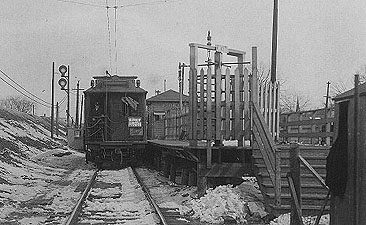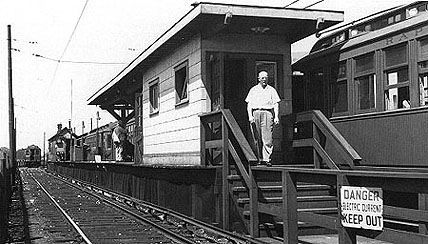|
|
|
|
 |
The Forest Park terminal looking east from the end of the line. When the station opened in 1910, just one track extended west from Wisconsin Avenue station, across Harlem to the Forest Park station. (Photo from the Walter R. Keevil Collection) |
|
|
|
|
 |
The Forest Park terminal looking east from the end of the line. When the station opened in 1910, just one track extended west from Wisconsin Avenue station, across Harlem to the Forest Park station. (Photo from the Walter R. Keevil Collection) |
Forest Park
(7300W/100S)
Marengo Avenue and Circle
Avenue, Village of Forest Park
Service Notes:
Lake Street Route
Quick Facts:
Address: TBD
Established: May 20, 1910
Original Line: Chicago & Oak Park Elevated
Previous Names: none
Rebuilt: n/a
Skip-Stop Type:
Station
Status: Demolished
History:
Previous to the Lake Street Elevated's 1901 extension straight west along South Boulevard in Oak Park, the "L" tracks turned south at Lombard Avenue to various lines and routes west on Randolph to Wisconsin (Marion) Avenue and south on Cuyler Avenue to Harrison Street. The Lake Street Elevated had many franchise disputes with the township of Cicero and village of Oak Park, but finally an agreement was made so that the Lake Street "L" would reach Wisconsin Avenue via South Blvd., a block east of Oak Park's city limits. For a decade after, various interurban railway promoters tried make franchise agreements to enter Oak Park from the west and use the Lake Street's line as an entryway into Chicago (the same way the Chicago Aurora & Elgin used the Met's Garfield Park Line). Only one of these, the Chicago & Elmhurst Railway, managed to build any track and it was used exclusively by the "L".
The C&E claimed to be unaffiliated with the "L", who had unsuccessfully been trying to get the city of Forest Park and other western suburban cities to grant them a franchise to extend west. By 1909, the Chicago & Oak Park (which the Lake Street "L" had by this time been reorganized as) and the adjacent Chicago & North Western Railroad had finally reached an agreement by which the "L" could extend its tracks west into the steam road's Forest Park yard about 1,200 feet, at which point the "L" was to cross under the railroad's main line. With this agreement in hand, C&OP President Clarence Knight was able to obtain a temporary permit to cross Harlem Avenue into Forest Park to access the C&NW property. A single track was placed into service in 1909, but use was limited to work trains. The C&OP requested permission to operate passenger trains and, in late March, 1910, it was granted, though technically in the name of the now-obviously affiliated C&E interurban. The franchise also allowed an extension southwest to Circle Avenue, but this was never built.
Initially, only this one track crossed Harlem Avenue to the Forest Park terminal. The lack of a discernible walkway from the street to the station resulted in a poor showing: there were "no trespassing" signs and a rail yard to navigate just to get to the station house. The installation of a sidewalk increased patronage significantly. Later, a second track, third rail (used for switching operations) and new buildings were added.
When the CTA elevated the suburban Lake Street "L" tracks in 1962, the Forest Park station (along with all the rest of the grade-level stations) was demolished. Instead of the rebuilding Forest Park and the Wisconsin (now called Marion) stations, one new station was built at Harlem as the line's terminal. The Lake "L" yard now occupies the site of the Forest Park station.
 The Forest Park terminal in 1946. By this time, a lot had changed at the station: a second track was added, a third rail was erected west of Harlem to speed switching operations and new buildings were erected. (Photo from the Charles E./Walter R. Keevil Collection) |
|
|